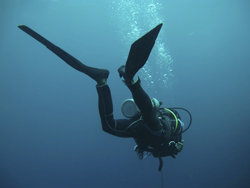Marine navigation systems for robot 'buddies'
Researchers came up with a mission concept to develop their system as part of the EU-funded CONMAR project. Their idea was to use a small group of autonomous surface vehicles to supervise and guide a human diver along a prescribed path. The diver receives commands from the robots as patterns of light from light emitting diodes (LEDs) installed on their diving mask. The robots send the commands using an acoustic channel. To achieve their mission goal, researchers had to develop an acoustic system capable of estimating the position of the vehicle relative to transponders or a ship. These must then be able to transmit the estimated position of the underwater vehicle back to the vehicle itself using an acoustic modem. It is not only the position that is important, but also the corresponding velocity and course angle. Researchers advanced a measurement model that performed well during diving mission simulations. The tool will become an integral part of NetMarSyS, a software suite for the simulation of cooperative multiple vehicle navigation and control systems. CONMAR culminated in sea trials in Lisbon, Portugal with three autonomous surface robots and a human diver. The robots navigated cooperatively, meaning that they shared resources to increase the performances of their individual navigation systems. This approach provides a robust system able to deal with acoustic outliers and temporary communication losses between the diver and the surface craft. Overall, tests indicated that the prototype system worked extremely well under real conditions, so it has the potential to move from the laboratory into the real world. The offshore industry and marine scientists, among others, stand to benefit from the navigation system as it brings them closer to cooperative human–robot missions at sea.







